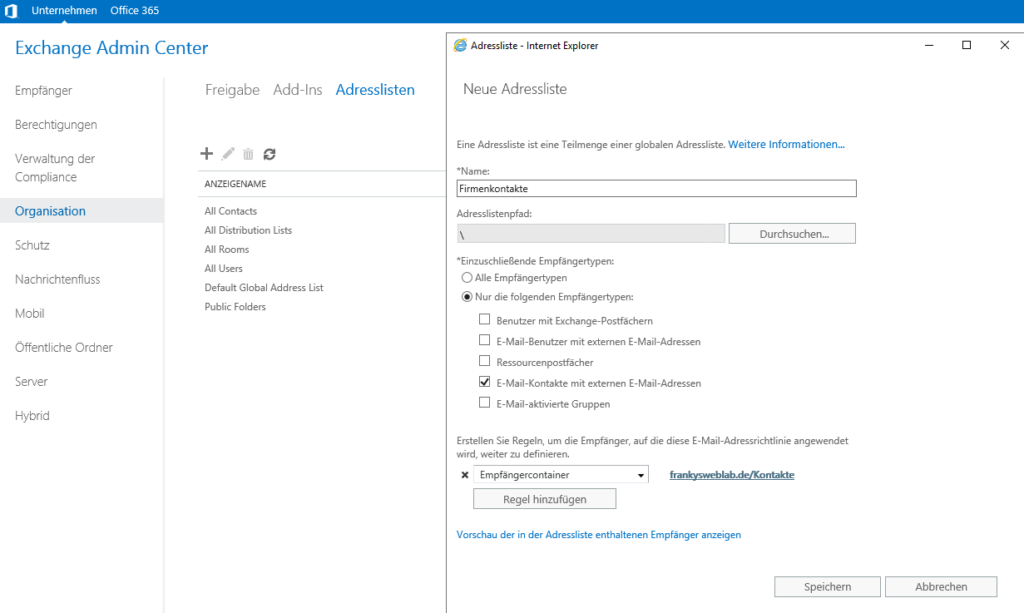A reader of this page asked whether it is possible for certain users to create and manage contacts for the organization. A separate RBAC (Role Based Access Control) role can be used for this with little effort. A corresponding role, which can only create and edit contacts in a specific organizational unit, can be created with little effort. Members of the role can then manage contacts via the Exchange Admin Center.
To enable the creation and management of contacts to be delegated, two new management roles must first be created. The new management roles are based on the existing roles (in this case "Mail Recipients" and "Mail Recipient Creation":
New-ManagementRole -Parent "Mail Recipients" -Name Contacts
New-ManagementRole -Parent "Mail Recipient Creation" -Name ContactCreation

All commands that are not required for creating contacts are now removed from the newly created management roles; this is done with the following two commands:
Get-ManagementRoleEntry -Identity "Contacts\*" | where {$_.Name -notlike "*MailContact"} | Remove-ManagementRoleEntry -confirm:$false
Get-ManagementRoleEntry -Identity "ContactCreation\*" | where {$_.Name -notlike "*MailContact"} | Remove-ManagementRoleEntry -confirm:$false

The two commands above have removed all commands that do not have "MailContact" in their name from the new Managemant roles. However, further commands are required to create and manage contacts. The other necessary commands must therefore be added again:
Add-ManagementRoleEntry -Identity "Contacts\Get-User"
Add-ManagementRoleEntry -Identity "Contacts\Get-Recipient"
Add-ManagementRoleEntry -Identity "Contacts\Set-Contact"
Add-ManagementRoleEntry -Identity "Contacts\Get-Contact"
Add-ManagementRoleEntry -Identity "ContactCreation\Get-OrganizationalUnit"
Add-ManagementRoleEntry -Identity "ContactCreation\Get-User"
Add-ManagementRoleEntry -Identity "ContactCreation\Get-Recipient"

The two management roles are now ready. A new organizational unit for the contacts can now be created in the Active Directory; the users will later only be given permission to create contacts within this organizational unit:

A new administrator role is now created in the Exchange Admin Center:

The new administrator role is now given the name "Contact Management", the write area is only entered after the role has been saved (otherwise an error message will appear). Furthermore, the previously created management roles are added and the members of the administrator role are defined:

Once the administrator role has been saved, the write area can also be customized. The canonical name of the organizational unit can now be entered here:

Entering the organizational unit prevents contacts from being created in other organizational units:

Members of the "Contact Management" administrator role can now log in to the Exchange Admin Center and only have the authorization to create and edit contacts:

Only a few details are required to create a new contact, and with a little training this should not be a problem. However, members of the role must always select the alias and the organizational unit. If the organizational unit is left blank or an OU outside the write area is selected, an error message is displayed:

If desired, a new address list containing the new contacts can be created:

Hallo,
ich habe das mit Exchange online versucht und bekomme bei „Get-ManagementRoleEntry -Identity „Contacts\*“ | where {$_.Name -notlike „*MailContact“} | Remove-ManagementRoleEntry -confirm:$false“
folgenden Fehler
Write-ErrorMessage : Cannot process argument transformation on parameter ‚Identity‘. Cannot convert value „Contacts“ to type
„Microsoft.Exchange.Configuration.Tasks.RoleEntryIdParameter“. Error: „Das Format des in den Parameter
Microsoft.Exchange.Configuration.Tasks.RoleEntryIdParameter eingegebenen Werts ist ungültig. Prüfen Sie den Wert, und versuchen Sie
es erneut.
Parameter name: identity“
In C:\Users\RRo\AppData\Local\Temp\tmpEXO_01qgvmyh.5dr\tmpEXO_01qgvmyh.5dr.psm1:1190 Zeichen:13
+ Write-ErrorMessage $ErrorObject
Wir haben eine hybride Umgebung, d.h. Exchange Online ist ebenfalls beteiligt, somit musste der Befehl umgebaut werden:
Get-ManagementRoleEntry „Contacts\*“ | where {$_.Name -notlike ‚*MailContact‘} | foreach {Remove-ManagementRoleEntry -Identity „$($_.id)\$($_.name)“ -confirm:$false}
siehe dazu auch „Beispiel 2“ hier:
https://learn.microsoft.com/de-de/powershell/module/exchange/remove-managementroleentry?view=exchange-ps#beispiel-2
Hallo Frank,
vielen Dank für diese hilfreiche Anleitung. Nun möchte ich, dass die eingeschränkten User auch die Adresslisten anlegen und die Kontakte und Exchange-User den Adresslisten hinzufügen können. Welche ManagementRoleEntry muss ich dafür den 2 Gruppen noch zuweisen?
Viele Grüße
Michael
Servus,
gibt es auch die Möglichkeit, der Rolle noch die Berechtigung zu geben, Gruppen zu erstellen/bearbeiten?
Gruß Oli
Grundsätzlich ja, aber da gibts halt keine ous. ;)
Hallo Frank,
Coole Lösung. Funktioniert das auch mit Exchange Online?
Viele Grüße